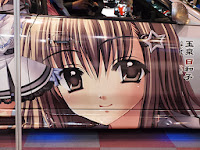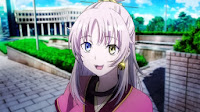 |
| Evangelion Photo Credit: Flickr Creative Commons Photo by Paul Evans |
My latest article on Squidoo addresses something I've struggled with for some time concerning anime, and that's the terminology required to understand the genres. My article on the subject on Squidoo, is called Understanding the Genres of Anime, and it tries to de-mystify some of the terms used to describe types of anime. It was not a comprehensive list, and I'd like to rectify that here.
Below is a list of all anime terminology that I've come across, and at least a brief description of each. Have a look, and let me know what you think in the comments.
 |
| Anime Car Photo Credit: Flickr Creative Commons Photo by tsukubajin |
- Kodomo or kodomomuke - Means child or childlike. This is anime directed at children. Typically young children under 10. Examples are Hello Kitty, Pokeman or Sonic X.
- Chibi - A Japanese term for a diminutive person, but in anime it means super deformed or SD. It typically depicts children with small bodies and huge heads for a comical effect. They are meant to be cute and more easily demonstrate extreme emotions. This is not a commonly used genre on its own, but frequently used to emphasize an emotion in a short instance in another genre of anime, such as Avatar: The Last Airbender, Ninja Turtles or several others. Some that use this exclusively are, SD Gundam Force, Hanamaru Kindergarten and Lucky Star.
- Kawaii - The word means lovable, cute or adorable. This is specifically a character that has been created solely for cuteness, such as Hello Kitty, Pikachu or Teletubbies. These shows are usually geared towards the youngest of crowds, such as kodomo, although there are a few exceptions.
- Shoujo or Shojo - This means girl, as in a female minor from 10-18. It is a show surrounding young girls, and there doings. It is very popular in Japan, and in fact the most popular of all anime genres. Some of the more popular include Sailor Moon, School Life and Maid Sama. Some common themes include relationships with boys, interactions with girls on a popularity level and school.
- Shoujo-ai - The literal Japanese, shoujo means girl, and ai means love. This is an anime that centers around lesbian relationships of usually younger girls. This specific genre doesn't show any nudity or anything explicit, but instead focuses on the relationship aspect of female attraction. It isn't por.nographic, but instead it's lesbian romance. Some examples are Blue Drop, Kampfer and Simoun
- Shounen - The literal translation is few years, but the word has become synonymous with male minors, such as Shoujo is for female minors, this is its male counterpart. As these are for younger men, typically teens, common themes include action, adventure and sports. Sometimes they include things like school and romance, but only included among a more major action oriented story. Just like Shouju, this is more a demographic than a genre, so it can actually have many different themes. It just needs to be aimed at young men. Some examples are Naruto, Bleach and Attack On Titan.
- Shounen-ai - This is a boy on boy romance story, that typically includes younger men. These types of stories do not include any explicit scenes, but are more focused on romance, and a great deal of kissing. Some examples of this are Sukisho, Princess Princess and Gakuen Heaven.
- Seinen - This is typically seen as meaning mature. Manga and anime that specifically targets young adult males around the ages of 18 to 25 are seinen titles. The stories in seinen works appeal to university students and those in the working world. Typically the story lines deal with the issues of adulthood. These are considered adult movies, but not por.nography. There may be some immorality, extreme violence and language, among some possible other things. Some examples include Monster, Berserk and Cowboy Bebop.
- Josei - Literally means woman. It targets women 18-30. This is the female equivalent to seinen. Unlike shoujo the romance is more realistic and less idealized. The storytelling is more mature. Some examples include Honey and Clover, Nana and Paradise Kiss.
- Bishojo or Bishoujo - In Japanese, this means beautiful young girl. It's not a genre or a demographic, but actually a character type. It is an indication that there is a pretty girl, or more than likely, many pretty girls in this anime. It's used in nearly all young adult anime, and it doesn't imply anything other than just that there will be pretty girls, along with others that maybe aren't so much. It's a character type used in many different genres and for many different demographics, such as Shoujo and Shounen.
- Bishonen or Bishounen - This is a Japanese term that means beautiful young boy, or in a better term, a pretty boy. It's more or less an attractive young male. This is a character type in many anime series and movies, and the characters are used in many different ways. There can be homosexual implications to it, but not always. These types of character usually appeal to young women, and are easily used for subjects of attraction. Think of the boy bands in America and England, and this is kind of the same philosophy.
- Mecha - The word mecha comes from a shortened version of the English word mechanical, and it's used to describe a genre of science fiction that focuses on human controlled machinery and robots. Some examples are the Gundam series, Neon Genesis Evangelion and Eureka Seven.
- hikikomori - This isn't a genre at all, and in fact just means literally "pulling inward, being confined." It's a term in Japan that would mean a recluse, and is typically the assignment of a key character in an anime to help add some suspense. It can be used in any types of movie or series, and really can't be assigned much specifically. Some examples of anime that have these types of characters are, Welcome to the N.H.K, Rozen Maiden and Sayonara, Zetsubou-Sensei.
- shinigami - This means death god or death spirit, and in fiction it has come to mean the Grim Reaper. It's actually from ancient Japanese religious references, which call on a god like being to bring on death. It's developed over time, much like the grim reaper or devil or many other ideas like this. This being has become fairly common in certain types of anime. Not necessarily any specific genre, but as a key character or force. Some examples are Death Note, Black Butler and Soul Eater.
- Ecchi - This is anime that is typically considered a bit on the "dirty" or erotic side. There's no actual sexually explicit scenes, but there are innuendos, some mild nudity and scantily glad men and women. Another term for this is fan service, which indicates, these will be certain characters dressed provocatively for fans to get a better view. Some examples of this are Queens Blade, Samurai Bride and High School of the Dead.
- Hentai - This is anime por.n. These are sparse story lines with full nudity and sexually explicit scenes. An example is Tsugou no Yoi Sexfriend? or some manga displayed on Prime Hentai.
- Yaoi - This is homoerotic stories about men in love for female audiences. These movies have explicit sex between two males, but this is a genre written by women and geared towards women to watch.
- Bara - These are homoerotic stories about men in love for homosexual male audiences. As opposed to Yaoi, these are much more realistic tales, and will include things such as a slice of life to help the realism come through.
- Yuri - This can also be called wasei-eigo, and it means something along the lines of girls' love. It deals with lesbian love affairs, and depicts explicit girl on girl scenes of an erotic nature. The types of stories can span many different genres as well as demographics. Some are geared towards women and others are geared towards men.
- Lolicon - These are stories surrounding a sexual attraction to under-aged girls.
- Shotacon - These are stories surrounding a sexual attraction to under-aged boys.
- Doujinshi - This is fan made manga.
- otaku - This is a Japanese word that indicates a person with a certain obsession. But it has lost its negative connotations, and now is more of a proclamation made by many anime fans to insist they are crazy for anime due to its insane popularity.
- seiyu or seiyuu - This is the word used to indicate a Japanese voice actor, which is fairly prominent, since Japan produces more than 60% of the animations in the world. These are highly trained voice actors, who's talents are extensibly used in all manor of media. Many of the most popular have developed adoring fan followings.
 |
| Anime Girl Eyes Photo Credit: Flickr Creative Commons Photo by Danny Choo |
For some more details on this, check out these resources:
So, there ya go. A vocabulary list of terms used to identify anime. I'll try to keep it updated periodically, but this should be enough to get started. If you have any suggestions, please let me know in the comments below.
 |
| Fan Service Swimsuit Girls Photo Credit: Flickr Creative Commons Photo by Manuel Siordia |

No comments :
Post a Comment